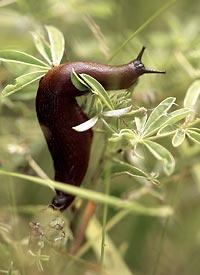Myths and truths about your slime-and-dine garden nemesis

Slug — rhyming with "ugh" — gives spring and summer gardeners fits of discomfort.
If slug-haters were successful hunters, slugs would be as extinct as the passenger pigeon.
But alas, slugs persist as one of the most troublesome of our local garden pests. Their appetite for fresh, new vegetation draws them to lily shoots, baby mesclun mix and dahlia foliage. Frustrated gardeners often imagine these mollusks deliberately select our favorite plants to attack.
Since there's no eliminating slugs completely, knowing a bit more about them may help you manage them.
Myth: All slugs do harm.
Truth: Native slugs, like the banana slug, deserve protection. Familiar to rain-forest hikers, banana slugs (Ariolimax columbianus) seldom appear in urban or even suburban gardens. Yellow, olive or brown in color and up to 4 inches long, they recycle forest debris.
Non-native slugs destroy gardens. Two of the most harmful are the common gray field slug (Agriolimax, gray to brown to buff colored) and the large black slug (Arion ater). They often gang up for maximum damage.
Myth: Freezing temperatures and hot summers kill slugs.
Truth: I'm afraid not. The brief spells of 20-degree weather we experienced this winter and the occasional summer forays into the 80s and 90s just slow them, but don't actually kill them.
In fact, my sister, who gardens near the Bighorn Mountains in Wyoming, with subzero winters and blistering summers, says she finds them in her tender spring plants.
Slugs and snails can burrow, sometimes following existing worm holes, to avoid cold. Their metabolism slows for protection from heat and drought. Wimpy weather conditions in Western Washington aren't going to rid us of them.
Myth: Adult slugs do the most damage.
Truth: Tiny new ones, hatched from last year's eggs, smaller than a pencil eraser, eat voraciously. They're hard to pick up and (sorry) too small to slice.
All slugs eat 30 to 40 times their weight daily; these babies will bulk up to about an inch long one month after emerging. Look for them under leaves of damaged plants.
Myth: They hang out on plants.
Truth: Look under pots, under pot edges and under wood or plastic in gardens.
I check under containers every other morning, scooping the slugs into a jar of soapy water. Handpicking this way does help reduce the population. Lay down traps like wet cardboard, plastic bags or wood shingles.
Myth: Slug bait alone will control them.
Truth: Use several methods. Combine the hunt-and-destroy method with traps. Beer traps work if the beer is fresh (cheap "lite" beer seems appreciated). Newer slug poisons contain iron phosphate (sold as Sluggo and WorryFree). These aren't toxic to dogs and cats as were the older types, baits with a nerve poison called metaldehyde. If you have children or pets, look for this ingredient — metaldehyde — and stay away from it.
Garden expert Mary Robson is a retired area horticulture agent for Washington State University/King County Cooperative Extension. Her e-mail is marysophia@olympus.net.
Removing slug slime: Water makes slime worse. Scrub it off with a paper towel doused in white vinegar, which dissolves slime. Interestingly, slugs can follow slime trails to food.
Sexual proclivities: Most slugs are hermaphrodites (both male and female). They mate with any slug they touch and when times are tough, they can even mate with themselves.
They're toothless: Damage often looks as if it's been done with a carpenter's rasp, and rightly so. Slugs have raspers that line up in rows in their mouths, and they pull away at plant fibers. As the rasps wear, the slug grows new ones.
Slug eggs: Produced in clumps of 40 to 100, they are laid most heavily in late summer or fall. They resemble piles of coated fertilizer, pearly and round. Look for them down in leaf litter or mulch, and destroy the clump.
Sharon Collman, Washington State University Extension agent in entomology